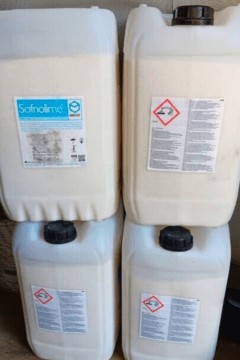Sorb, or scrubber, plays a critical role in rebreather diving, as it is responsible for removing carbon dioxide from the diver’s breathing gas. Small granules or pellets absorb exhaled carbon dioxide and allow oxygen to pass through. This chemical process allows rebreathers to recycle exhaled air, limiting gas consumption and allowing longer dives. Once saturated, the sorb must be disposed of. The method of disposal can differ by region (due to local regulations) as well as by the chemical makeup of the used scrubber. Manufacturers’ recommendations are often conflicting and may read, “Use a qualified industrial waste disposal facility. Dispose of waste according to local and Federal laws and regulations,” or “May be disposed of in household waste landfill.” Knowledge of sorb and its chemical components is important for both safe rebreather diving and environmentally responsible practice.
How Does Scrubber Work?
Soda lime, the most common scrubber material, contains a mixture of calcium hydroxide and sodium hydroxide. When the diver exhales, carbon dioxide travels through the loop through the sorb canister, which contains pellets or granules of calcium hydroxide and sodium hydroxide. Carbon dioxide from the exhaled breath then reacts with the hydroxide ions to form bicarbonate ions. The bicarbonate ions react with calcium hydroxide and produce calcium carbonate; in this process, the calcium carbonate stays trapped in the sorb, and the used hydroxide ions are regenerated, so they can continue to react with more carbon dioxide. Different factors including the type and particle size of the pellets, water temperature, and the diver’s workload can impact the lifetime of the sorb.After prolonged use, the sorb becomes “saturated” with calcium carbonate and needs replacement. The residual sodium hydroxide has a high pH when dissolved in water but will over time dissolve in water and neutralize with any acid into water and salt.
After prolonged use, the sorb becomes “saturated” with calcium carbonate and needs replacement. The residual sodium hydroxide has a high pH when dissolved in water but will over time dissolve in water and neutralize with any acid into water and salt.
The Problem of Scrubber Disposal
Because of the chemicals involved, disposing of sorb should be done thoughtfully. Consulting safety data sheets of manufacturers, it may often be classified as “inorganic wastes containing hazardous substances”. Calcium hydroxide can potentially harm marine life and ecosystems if it’s simply dumped into the water, a not uncommonly reported practice, e.g. on some liveaboards. The International Treaty to Prevent Pollution from Ships (MARPOL), which the U.S. has endorsed, outlaws the throwing of any garbage “into the water from a vessel that is on a lake, river, stream, or any coastal waters up to 3 miles offshore.” (Garbage Disposal Laws Fact Sheet, National Marine Manufacturers Association)
In the United States, used sorb is too often errantly considered non-hazardous. Depending on the exact chemical composition of the used scrubber material, throwing it out in regular municipal waste may therefore be both illegal and environmentally harmful. While fully used scrubber material would be composed entirely of non-hazardous calcium carbonate, the fact is that it usually isn’t, which means it may contain some environmentally toxic sodium hydroxide and would therefore be unsuitable for regular municipal disposal. Strictly following regulations, sodium hydroxide is considered hazardous waste and must be disposed of properly at a local hazardous waste collection site, normally co-located with landfills. According to the U.S. Code of Federal Regulations (CFR Title 40, Part 261), it is ultimately the responsibility of the generator of the potentially hazardous waste (in this case, the rebreather diver) to dispose of it following all local, state, and federal regulations.
The rebreather diver who dives in various locations must ensure they understand all applicable laws and practices for each jurisdiction where they generate, store, and dispose of potentially hazardous waste.
Best Practices
Regardless of your location, there are a few best practices to remember. Always follow the disposal guidelines provided by the manufacturer of the sorb or the rebreather and confirm that this method of disposal follows all local, state, and federal disposal laws. Do not dump used sorb into the water. While rebreather and sorb manufacturers may provide guidance for disposal, it is ultimately the responsibility of the diver to determine if their used sorb is considered hazardous waste or suitable for municipal waste and dispose of it in compliance with all applicable laws and regulations.
